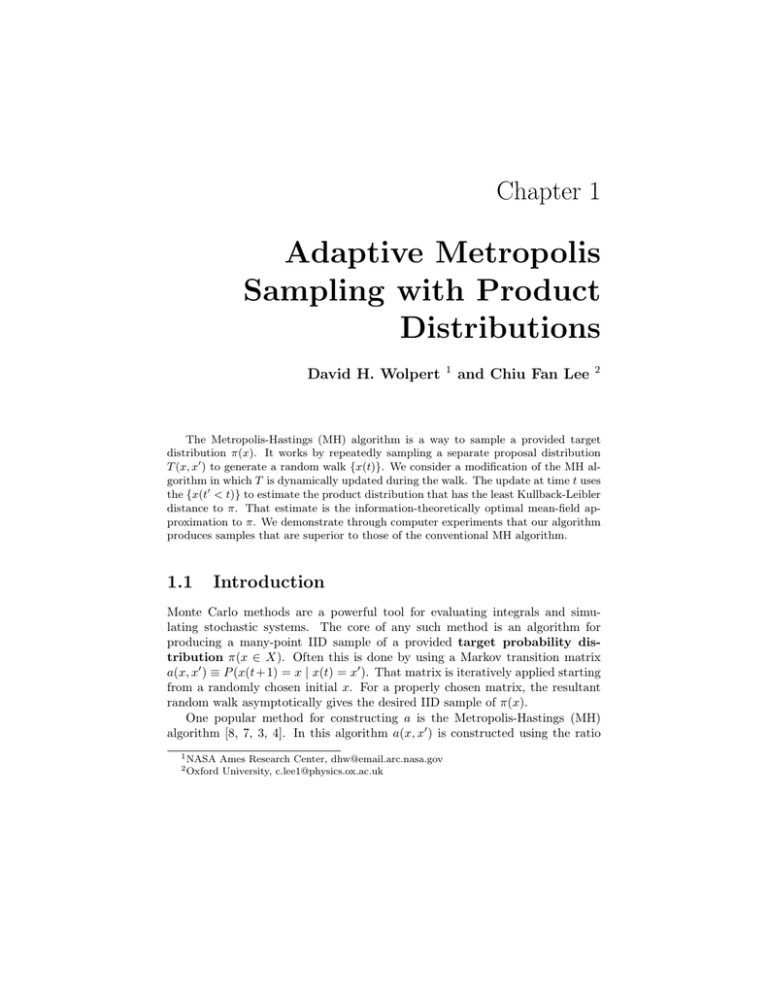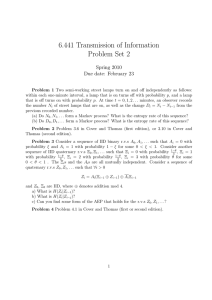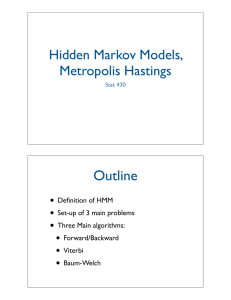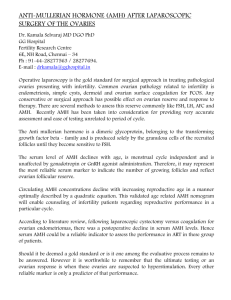Adaptive Metropolis Sampling with Product Distributions Chapter 1
advertisement

Chapter 1
Adaptive Metropolis
Sampling with Product
Distributions
David H. Wolpert
1
and Chiu Fan Lee
2
The Metropolis-Hastings (MH) algorithm is a way to sample a provided target
distribution π(x). It works by repeatedly sampling a separate proposal distribution
T (x, x0 ) to generate a random walk {x(t)}. We consider a modification of the MH algorithm in which T is dynamically updated during the walk. The update at time t uses
the {x(t0 < t)} to estimate the product distribution that has the least Kullback-Leibler
distance to π. That estimate is the information-theoretically optimal mean-field approximation to π. We demonstrate through computer experiments that our algorithm
produces samples that are superior to those of the conventional MH algorithm.
1.1
Introduction
Monte Carlo methods are a powerful tool for evaluating integrals and simulating stochastic systems. The core of any such method is an algorithm for
producing a many-point IID sample of a provided target probability distribution π(x ∈ X). Often this is done by using a Markov transition matrix
a(x, x0 ) ≡ P (x(t+1) = x | x(t) = x0 ). That matrix is iteratively applied starting
from a randomly chosen initial x. For a properly chosen matrix, the resultant
random walk asymptotically gives the desired IID sample of π(x).
One popular method for constructing a is the Metropolis-Hastings (MH)
algorithm [8, 7, 3, 4]. In this algorithm a(x, x0 ) is constructed using the ratio
1 NASA
2 Oxford
Ames Research Center, dhw@email.arc.nasa.gov
University, c.lee1@physics.ox.ac.uk
2
Adaptive Metropolis Hastings
π(x)/π(x0 ), together with a proposal distribution T (x, x0 ). Typically T is
set before the start of the Markov chain in a π-independent manner and fixed
throughout the running of that chain. The rate at which the random walk
produced in the associated Markov chain converges to the desired IID sample is
crucially dependent on the relation between T and π however.
An important example of this is that if T (x, x0 ) = π(x), then the MH Markov
chain is a perfect IID sampler of π (see below). Unfortunately, typically one
cannot exploit this because one cannot evaluate π(x). (Only the ratios of π(x)
values for different x can be evaluated.) However since the set {x(t)} produced
by the MH algorithm is (eventually) an IID sample of π, one can use {x(t)} to
produce a empirical estimate of π [2].
This suggests that we empirically update T during the random walk to be
an increasingly accurate estimate of π. Intuitively, the idea is to try to find the
density q ∈ Q that is “closest” to π and using that to update T , presuming
that this will produce the most quickly converging random walk. We generically
call such algorithms Adaptive Metropolis Hastings (AMH). To specify an AMH
algorithm one must fix the choice of Q, the measure of closeness, and the precise
details of the resultant density estimation algorithm. One must then specify
how the estimates of π(x) are used to update T (x, x0 ).
Typically X is high-dimensional, and for the density estimation of π to
work well it must be restricted to producing estimates from a relatively lowdimensional space, Q. According,
here we choose Q to be the set of all product
Q
distributions over X, q(x) = i qi (xi ). (Loosely speaking, this is equivalent to a
mean-field approximation.) The most popular way to measure closeness between
probability distributions,
P which we adopt here, is with the Kullback-Leibler (KL)
distance, D(p||p0 ) ≡ − x p(x)ln[p0 (x)/p(x)] [1].
Given our choice of Q, D(q||π) is minimized for q obeying qi (xi ) ∝
−βE(ln(π)|xi )
e
∀i [9, 10]. Unfortunately, usually we cannot solve this coupled
set of equations in closed form. However we can use sampling processes to perform an iterative search for such D(q||π)-minimizing q. To do this, we use IID
samples of q to form estimates of E(ln(π) | xi = s) for all variables xi and
associated potential values s. Those estimates are all that is needed to perform
a step in a Newton’s method search for argminq [D(q||π)] [9, 10, 6]. Because Q
is a product distribution, this estimation procedure scales well to large spaces
X. Moreover, by construction, the estimates and the associated updates of q
are parallelized, lending the algorithm to particularly fast implementation.
Another alternative, explored here, is to consider the KL distance from π
to q rather than vice-versa. It can be argued that this is more correct, given
the information-theory basis of KL distance [9, 10]. The product distribution
minimizing this distance has the same marginals as π, i.e., obeys qi = πi ∀i [9,
10]. Moreover, as the random walk of the conventional MH algorithm converges
to the desired IID sample of π, the i’th component of the elements of the random
walk, {xi (t)}, becomes an IID sample of πi (xi ). So if the number of possible
xi values is small, we can use histogramming of the random walk produced by
the MH algorithm to estimate π. We don’t have to run an extra process of IID
Adaptive Metropolis Hastings
3
sampling of q and updating it accordingly to form such an estimate.
In the next section we review the MH algorithm. Next we present our AMH
algorithm. We end with experiments validating our algorithm.
1.2
Metropolis-Hastings algorithm
P
For a transition matrix a(x, y) to preserve probability, x a(x, y) = 1 ∀y (since
P
x,z a(x, z)δ(y, z) must equal 1 for all y). Conservation of probability also means
that all eigenvectors that lie on the unit simplex have eigenvalue 1, i.e., they are
fixed points of a. All other eigenvectors connect points within the simplex,
i.e., have the sum of their components = 0.3 Moreover those eigenvectors have
eigenvalues < 1, as otherwise repeated application of a to a point in the simplex
that isn’t an eigenvector would map it off the simplex.
So if a is full-rank and we express a distribution in terms of the eigenvectors
of a, we see that running that distribution through a maps it geometrically closer
to the subregion of the simplex spanned by a’s fixed points. Furthermore, that
fixed point is unique if the following hold:
• irreducible: The probability of moving from any one state to any other
state in a finite number of applications of a is non-zero;
• aperiodic: The probability that the state is unchanged under a is nonzero.
When these conditions hold, a Markov chain based on a will map any initial
point y (i.e., any initial distribution over x values, δ(x, y)) to its unique fixed
point distribution. So say we produce many such converged Markov chains
starting from y. Then the set of last points in each chain will form a many-point
IID sample of the fixed point distribution of a. Since this is true for any y,
we can instead run those Markov processes one after the other, i.e., run one
particularly long Markov chain. This provides our sample of π.
The MH algorithm exploits this by constructing a transition matrix with
an eigenvector that is the desired distribution π. In many of the domains in
which MH is used, that a is irreducible and aperiodic, so we are guaranteed of
convergence to π, if π is an eigenvector. In MH a implicitly defined as follows:
1. Given current state x(t), draw y from the proposal distribution T (x(t), y).
2. Draw a random number r uniformly in [0, 1] and update
½
y,
if r ≤ R(x(t), y)
x(t + 1) =
x(t), otherwise
where
3 To
P
see this write
(1.1)
¾
½
π(y)T (y, x)
.
R(x, y) = min 1 ,
π(x)T (x, y)
P
a(x, y)v(y) =
y
P
P
a(x, y) = 1, you get
x
v(y) = α
y
(1.2)
αv(x), and then sum both sides over x.
v(x), which for α 6= 1 implies
x
P
v(x) = 0.
x
Since
4
Adaptive Metropolis Hastings
Note that as claimed previously, for T = π, R always equals 1, and the newly
sampled point is always accepted.
Writing it out, for the MH algorithm
a(x(t + 1), x(t)) = min[1,
T (x(t), x(t + 1)) π(x(t))
].
T (x(t), x(t + 1)) π(x(t + 1))
(1.3)
For the distribution b to be a fixed point of this transition matrix it suffices to
have detailed balance:
a(x0 , x) bt (x) = a(x, x0 ) bt (x0 ) ∀x, x0 .
(1.4)
If both T and π are nowhere zero, this means that b must equal π. (These
conditions can be weakened, but suffice for this synopsis of MH.) So for such T
and π there is only one fixed point of a, and it is π, as desired.
We can generalize the foregoing by allowing T and therefore a to update
stochastically in a Markovian way. To be concrete, say that for all t, x(t + 1)
is set stochastically from T t and x(t), as in Eq. 1.3. After this T t+1 is set
stochastically from x(t + 1) and T t , and then the two-step process repeats.
All of the discussion above about geometric convergence to a fixed point still
holds for Markovian evolution over (x, T ). Any such fixed point b(x, T ) must
obey
Z
b(x, T ) =
dx0 dT 0 P (x, T | x0 , T 0 )b(x0 , T 0 )
Z
=
dx0 dT 0 P (T | x0 , T 0 )P (x | x0 , T 0 )b(x0 , T 0 )
Z
0
=
dx0 dT 0 P (T | x0 , T 0 )aT (x, x0 )b(x0 , T 0 )
Z
Z
0
=
dT 0 b(T 0 ){ dx0 P (T | x0 , T 0 )aT (x, x0 )b(x0 | T 0 )}. (1.5)
0
where aT is defined in the obvious way.
For any fixed point b to provide us with an IID sample of π it will suffice if
b(x | T ) = π(x) ∀T . Now assume T evolves slowly, i.e., P (T | x0 , T 0 ) ≈ P (T | T 0 ).
This allows us to pull it out of the integral over x0 . Then since π is an eigenvector
of a, our equality does indeed hold if ∀T 0 , b(x0 | T 0 ) = π(x0 ).
So as long as T changes slowly enough, π is still a fixed point. Moreover,,
depending on how many iterations are needed for the unvarying T t , and on the
details of P (T | x0 , T 0 ), it is one we reach far more quickly than under unvarying
T t . This is what AMH algorithms try to exploit.
1.3
Our AMH algorithm
1.3.1
General considerations
As mentioned above, our AMH algorithm is based on using the random walk to
form increasingly accurate estimates of π and then update T t accordingly, i.e., it
Adaptive Metropolis Hastings
5
is a particular choice of P (T t+1 | x(t + 1), T t ). There are a number of subtleties
one should account for in making this choice.
In practice there is almost always substantial discrepancy between π and q,
since Q is a small subset of the set of all possible π. This means that setting
T (x, y) = q(x) typically results in frequent rejections of the sample points. The
usual way around this problem in conventional MH (where T is fixed before the
Markov process starts) is to restrict T (x, y) so that x and y must be close to one
another. Intuitively, this means that once the walk finds an x with high π(x),
the y’s proposed by T (x, y) will also have reasonable high probability (assuming
π is not too jagged). We integrate this approach into our AMH algorithm by
setting T (x, y) to be q(y) “masked” to force y to be close to x.
Another important issue is that the earlier a point is on the random walk,
the worse it serves as a sample of π. To account for this, one shouldn’t form
qi (xi = s) simply as the fraction of the points for which xi (t) = s. Instead we
form those estimates by geometrically aging the points in forming q. This means
that more recent points have more of an effect on our estimate of π. This aging
has the additional advantage that it makes the evolution of τ a relatively lowdimensional Markov process, which intuitively should help speed convergence.
In [3, 7, 4] related ideas of how to exploit online-approximations of π that
are generated from the random walk were explored. None of this work explicitly
considers information-theoretic measures of distance (like KL distance) from the
approximation to π. Nor is there any concern to “mask” the estimate of π in
this work. The algorithms considered in this work also make no attempt to
account for the fact that the early x(t) should be discounted relative to the later
ones. In addition, not using product distributions, parallelization would not be
as straightforward with these alternatives schemes.
1.3.2
Details of our algorithm
Let N be the number of components of x and q t the estimate of π at the t’th
step of the walk. We consider the following algorithm:
1. Set T t (x, y) to q t (y) masked so that y and x differ in only one component:
t
T (x, y) ∝ δ
ÃN
X
i=1
!
δ(xi − yi ) − N + 1
N
Y
qit (yi ) .
(1.6)
k=1
2. As in conventional MH, sample [0, 1] uniformly to produce a r and set
½
y,
if r ≤ Rt (x(t), y)
x(t + 1) =
(1.7)
x(t), otherwise
where
¾
½
π(y)T t (y, x)
.
R (x, y) = min 1 ,
π(x)T t (x, y)
t
(1.8)
6
Adaptive Metropolis Hastings
3. Once the chain has settled somewhat, start accumulating the sample: If
t + 1 > C, add x(t + 1) to the sample set Dt+1 .
4. Once the chain has settled, periodically update q:
If t + 1 > C and modN (t + 1) = 0, then update the set {qit }:
qit+1 (x0i ) = ΩDt+1 (qit (x0i )) ∀i, x0i .
(1.9)
If t + 1 > C and modN (t + 1) 6= 0, then qit+1 (x0i ) = qit (x0i ) ∀i.
5. t ← t + 1. Repeat from step 1.
In “continuous updates”, ΩDt+1 defines geometric updating of q t by the nonnegative multiplier α < 1:
ΩDt+1 (qit (xi (t + 1)))
ΩDt+1 (qit (x0i
6= xi (t + 1)))
= α(qit (xi (t + 1)) − 1) + 1
(1.10)
= αqit (x0i ).
(1.11)
We also considered an alternative in which Ωt+1 is set in a manner similar to
that used in [7]. Under this alternative, “resampling updates”, one uniformly
randomly samples Dt+1 to form a sample S of L points. One then sets
ΩDt+1 (qit (x0i )) =
Lx0i
L
(1.12)
where Lx0i is the number of x ∈ S such that xi = x0i .
1.4
Experiments
Currently there is no consensus on how to quantify “how close” a set {x(t)}
is to an IID sample of π. One approach is to input the sample into a density
estimation algorithm [2]. One can then use KL distance from that estimated
distribution to π as the desired quantification. This can be problematic in highdimensional spaces though, where the choice of density estimation algorithm
would be crucial. However say we have a contractive mapping F : x ∈ X → y ∈
Y where Y is a low-dimensional space that captures those aspects of X that are
of most interest. We can apply F to the random walk to produce its image in
Y . Next one can apply something as simple and (relatively) unobjectionable as
histogramming to do the density estimation in Y . We can then use KL distance
between that histogram and F (π) as the desired quantification of how good our
transition matrix is. This the approach we took here.
All of our experiments had C = 10000 and α = 0.99. All results reported
are for 100 separate 20000-step Makrov chains. In our spin glass experiments
the states for each spin (i.e., each xi ) are {−1, 1}, and -ln(π(x)) is the “energy”
E(x) =
X
1 X
Jij xi xj +
hi xi
2 <i,j>
i
(1.13)
Adaptive Metropolis Hastings
0.02
7
0.035
AMH (cont. updates)
MH
AMH (with 100 samples)
AMH (cont. updates)
MH
AMH (with 100 samples)
0.018
0.016
0.025
KL distance
KL distance to the true distribution
0.03
0.014
0.02
0.012
0.015
0.01
0.008
0.9
1
1.1
1.2
1.3
1.4
1.5
1.6
1.7
1.8
0.01
0.9
1.9
1
1.1
1.2
1.3
Temperature
1.4
1.5
1.6
1.7
1.8
1.9
Temperature
(a)
(b)
2
0.07
AMH
MH
AMH
MH
1.8
0.06
1.6
0.05
1.2
KL distance
KL distance
1.4
1
0.8
0.04
0.03
0.6
0.02
0.4
0.2
0.3
0.4
0.5
0.6
0.7
Temperature
(c)
0.8
0.9
1
1.1
0.01
0.3
0.4
0.5
0.6
0.7
Temperature
0.8
0.9
1
1.1
(d)
Figure 1.1: KL accuracy of samples, for energy and for the number of xi that equal
1, for the spin glass problem ((a) and (b) respectively) and for the 3-SAT problem.
where the sum is over all neighboring pairs on a two-dimensional rectangular
grid. The constants {Jij , hi } are generated uniformly from the interval [−1, 1].
We also considered a 3-SAT-problem with 20 variables and 85 clauses (so the
problem is hard as 85/20=4.25). Negations in clauses and inclusion in a clause
are randomly generated. The parameters in the simulation are the following;C =
10000, and α = 0.99. Here the energy is -1 times the number of violated clauses.
The figure shows that in these experiments, AMH outperforms conventional
MH, and continuous updating gave better results than resampling updating.
8
Adaptive Metropolis Hastings
1.5
Other uses of q
The q produced by AMH has many uses beyond improved sampling. It can be
used as an estimate of the marginals of π, i.e., as an estimate of the optimal meanfield approximation to π. Because they are product distributions, the successive
q t can also be used as the control settings in adaptive distributed control [10, 5].
(In this application {x(t)} is the sequence of control variable states and π is
log of the objective function.) It’s being a product distribution also means that
the final q can be used to help find the bounded rational equilibria of a noncooperative game with shared utility functions [9].
Acknowledgements: We thank Bill Macready for stimulating discussion.
C.F.L. is a Junior Research Fellow at University College (Oxford) and he thanks
NASA and NSERC (Canada) for finanical support.
Bibliography
[1] Cover, T., and J. Thomas, Elements of Information Theory, WileyInterscience New York (1991).
[2] Duda, R. O., P. E. Hart, and D. G. Stork, Pattern Classification (2nd
ed.), Wiley and Sons (2000).
[3] Gasemyr, Jorund, “On an adaptive version of the metropolis-hastings
algorithm”, Scandinavian Journal of Statistics 30 (2003), 159–173.
[4] J.N.Corcoran, and U. Schnieder, “Pseudo-perfect and adaptive variants of the metropolis-hasting algorithm”, unpublished (2004).
[5] Lee, C. Fan, and D. H. Wolpert, “Product distribution theory for control
of multi-agent systems”, Proceedings of AAMAS 04, (2004), in press.
[6] Macready, W., and D. H. Wolpert, “Distributed optimization”, Proceedings of ICCS 04, (2004).
[7] Sims, Christopher, “Adaptive metropolis-hastings sampling”, unpublished
(1998).
[8] West, Mike, “Mixture models, monte carlo, bayesian updating and dynamic models”, Computing Science and Statistics 24 (1993), 325–333.
[9] Wolpert, D. H., “Information theory — the bridge connecting bounded
rational game theory and statistical physics”, Complex Engineering Systems (A. M. D. Braha and Y. Bar-Yam eds.), (2004).
[10] Wolpert, D. H., and S. Bieniawski, “Theory of distributed control using
product distributions”, Proceedings of CDC04, (2004).







